IDENTIFYING FUNCTIONS WORKSHEET
In the following problems, give the domain and range of each relation. Tell whether the relation is a function. Explain.
Problem 1 :

Problem 2 :
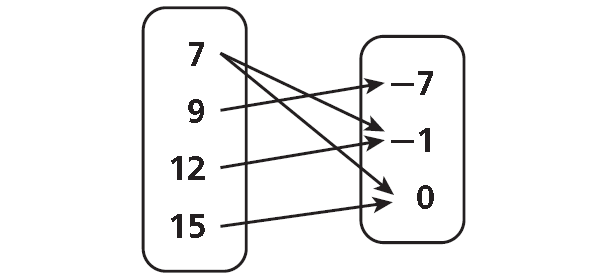
Problem 3 :

Problem 4 :
{(8, 2), (-4, 1), (-6, 2), (1, 9)}
Problem 5 :
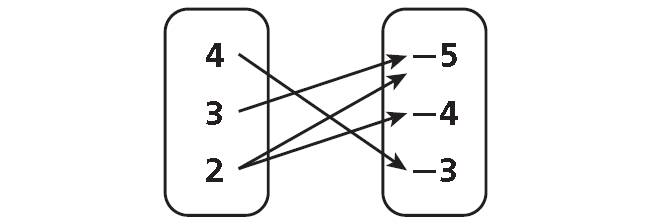
Problem 6 :
Let A = {-3, -2, -1, 1, 2, 3, 4} and B = {1, 4, 9, 16, 25}. R is the relation which maps the elements from A to B using the rule f(x) = x2.
Problem 7 :
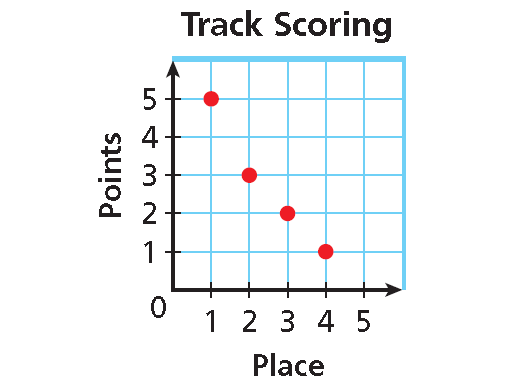
Problem 8 :
A = {1, 2, 3, 4} and B = {2, 5, 8, 11, 14} be two sets.
Let f : A--->B be a relation given by f(x) = 3x −1.

Answers
1. Answer :
Domain = {75, 68, 125}
Range = {2, 3}
(Even though 2 appears twice in the table, it is written only once when writing the range)
This relation is a function. Each domain value is paired with exactly one range value.
2. Answer :
Domain = {7, 9, 12, 15}
Range = {-7, -1, 0}
Use the arrows to determine which domain values correspond to each range value.
This relation is not a function. Each domain value does not have exactly one range value. The domain value 7 is paired with the range values -1 and 0.
3. Answer :
Draw lines to see the domain and range values.
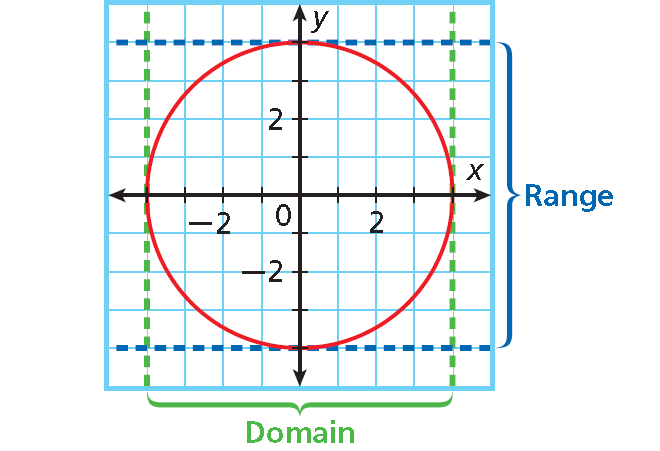
The domain is all x-values from -4 through 4, inclusive.
Domain : -4 ≤ x ≤ 4
The range is all y-values from -4 through 4, inclusive.
Range : -4 ≤ y ≤ 4
To compare domain and range values, make a table using points from the graph.

This relation is not a function because there are several domain values that have more than one range value. For example, the domain value 0 is paired with both 4 and -4.
4. Answer :
Domain = {8, -4, -6, 1}
Range = {2, 1, 9}
This relation is a function. Each domain value is paired with exactly one range value.
5. Answer :
Domain = {4, 3, 2}
Range = {-5, -4, -3}
This relation is not a function. Each domain value does not have exactly one range value. The domain value 2 is paired with the range values -5 and -4.
6. Answer :
R maps the elements from A to B using the rule
f(x) = x2
Then, we have
f(-3) = (-3)2 = 9
f(-2) = (-2)2 = 4
f(-1) = (-1)2 = 1
f(1) = 12 = 1
f(2) = 22 = 4
f(3) = 32 = 9
f(4) = 42 = 16
So,
R = {(-3, 9), (-2, 4), (-1, 1), (1, 1), (2, 4), (3, 9), (4, 16)}
Therefore,
Domain (R) = {-3, -2, -1, 1, 2, 3, 4}
Range (R) = {1, 4, 9, 16}
This relation is a function. Each domain value is paired with exactly one range value.
7. Answer :
To compare domain and range values, make a set of ordered pairs using points from the graph.
{(1, 5), (2, 3), (3, 2), (4, 1)}
Domain = {1, 2, 3, 4}
Range = {5, 3, 2, 2}
This relation is a function. Each domain value is paired with exactly one range value.
8. Answer :
A = {1, 2, 3, 4}; B = {2, 5, 8, 11, 14}; f (x) = 3x −1
|
f(1) = 3(1) – 1 = 3 – 1 = 2 |
f(2) = 3(2) – 1 = 6 – 1 = 5 |
|
f(3) = 3(3) – 1 = 9 – 1 = 8 |
f(4) = 3(4) – 1 = 12 – 1 = 11 |
Represent the relation f : A--->B by an arrow diagram.
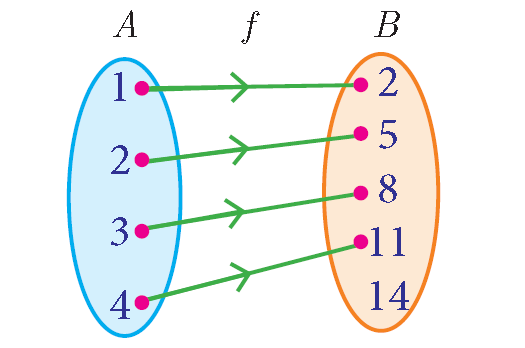
Domain = {1, 2, 3, 4}
Range = {2, 5, 8, 11}
This relation is a function. Each domain value is paired with exactly one range value.
Kindly mail your feedback to v4formath@gmail.com
We always appreciate your feedback.
©All rights reserved. onlinemath4all.com
Recent Articles
-
Trigonometry Even and Odd Iidentities
May 05, 24 12:25 AM
Trigonometry Even and Odd Iidentities -
SOHCAHTOA Worksheet
May 03, 24 08:50 PM
SOHCAHTOA Worksheet -
Trigonometry Pythagorean Identities
May 02, 24 11:43 PM
Trigonometry Pythagorean Identities

